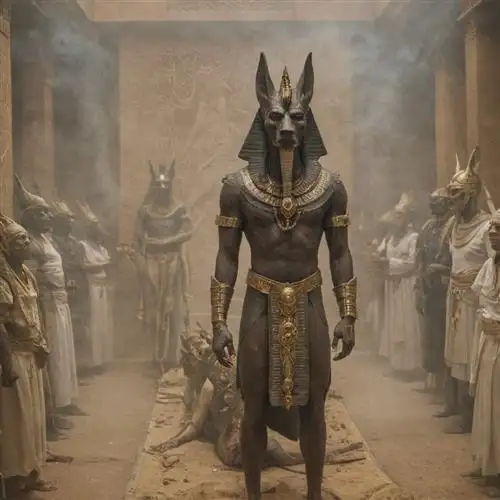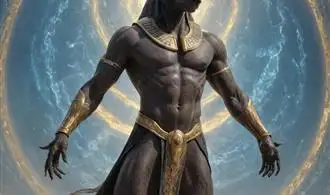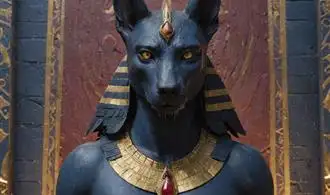
Ancient Egyptian God of the Afterlife
Anubis, the enigmatic and revered figure of ancient Egyptian mythology, has long captivated the imagination of scholars and enthusiasts alike. As the god of the afterlife, Anubis played a crucial role in the intricate beliefs and funerary practices of the ancient Egyptians. His influence and symbolism extended far beyond the realms of death, shaping the very fabric of their spiritual and cultural landscape.
At the heart of Anubis' significance lies his role as the guardian of the dead and the overseer of the mummification process. Responsible for the transformation of the deceased into the next life, Anubis was believed to guide the soul through the treacherous journey of the afterlife, ensuring a safe passage to the realm of the eternal. This profound responsibility was reflected in his iconography, where he is often depicted with the head of a jackal or a dog, animals revered for their keen senses and ability to navigate the unknown.
The ancient Egyptians' intricate beliefs surrounding the afterlife were central to their understanding of Anubis. They believed that upon death, the soul would undergo a series of rituals and judgments, with Anubis playing a pivotal role in the weighing of the heart ceremony. In this sacred ritual, the deceased's heart would be weighed against the feather of truth, symbolizing the balance between the individual's deeds and the cosmic order. Anubis, as the god of mummification and the guardian of the dead, would oversee this process, ensuring the soul's successful transition to the afterlife.
Beyond his role in the afterlife, Anubis held a multifaceted position within the Egyptian pantheon. He was also associated with the protection of the living, particularly in matters of health and healing. The jackal-headed deity was believed to have the power to ward off evil spirits and to provide guidance and comfort to those facing the challenges of the mortal realm.
The worship of Anubis extended throughout ancient Egypt, with temples and shrines dedicated to him found in various regions. The city of Cynopolis, located in the Nile Delta, was known as the primary center of Anubis' cult, where his priests would perform the intricate rituals and ceremonies associated with the god of the afterlife.
The Symbolic Significance of Anubis
Anubis, the ancient Egyptian deity associated with the afterlife, holds a profound symbolic significance that continues to captivate scholars and enthusiasts alike. As the god of embalming and the protector of the dead, Anubis played a crucial role in the Egyptian funerary practices and beliefs about the journey into the afterlife.
One of the most striking aspects of Anubis' symbolism is his canine-headed appearance. This distinctive feature links him to the jackal, a scavenger animal known for its presence around tombs and its ability to navigate the liminal spaces between the world of the living and the dead. The jackal's keen senses and instincts for finding and guarding the deceased were seen as essential qualities for Anubis to fulfill his role as the gatekeeper of the afterlife.
Beyond his physical form, Anubis' symbolic significance also extends to his responsibilities and associations. As the god of embalming, Anubis oversaw the mummification process, ensuring the preservation of the deceased's body for the journey into the afterlife. This vital task was seen as a sacred duty, as the preservation of the physical form was believed to be crucial for the soul's continued existence in the afterlife.
Anubis' role as the guide and protector of the dead is further exemplified in his presence during the weighing of the heart ceremony, a crucial moment in the Egyptian funerary rites. During this ritual, the deceased's heart was weighed against the feather of Ma'at, the goddess of truth and justice. Anubis, as the psychopomp (the guide of souls), would oversee this process, ensuring the deceased's heart was found to be pure and worthy of entering the afterlife.
The symbolic significance of Anubis also extends to his association with the color black. In ancient Egyptian symbolism, the color black was often associated with the fertile soil of the Nile River, which was essential for the growth and sustenance of life. However, in the context of Anubis, the color black also represented the regenerative and transformative aspects of death, as the journey into the afterlife was seen as a necessary step for the soul's continued existence.
Anubis and the Mummification Process
Anubis, the ancient Egyptian god of the dead and mummification, played a crucial role in the intricate process of preserving the physical bodies of the deceased. As the patron deity of this sacred ritual, Anubis's influence and significance cannot be overstated. The mummification process, often seen as a means to ensure the smooth transition of the deceased into the afterlife, was a meticulously planned and executed procedure that required the divine guidance of Anubis.
At the heart of the mummification process was the belief that the preservation of the physical body was essential for the soul's continued existence in the afterlife. Anubis, with his jackal-like head and canine features, was responsible for overseeing the entire process, ensuring that every step was carried out with the utmost care and reverence. From the initial embalming to the wrapping and final adornment of the mummy, Anubis's presence was palpable, guiding the priests and embalmers in their sacred duties.
One of the key aspects of Anubis's role in the mummification process was the removal of the internal organs. This delicate task was performed with great precision, as the organs were considered essential for the afterlife journey. Anubis was believed to be the one who severed the organs and placed them in canopic jars, which were then sealed and placed alongside the mummy. This process not only preserved the body but also ensured the continued existence of the individual in the afterlife.
Additionally, Anubis was responsible for weighing the deceased's heart against the feather of truth, a symbolic representation of the judgment of the soul. This ritual, known as the "Weighing of the Heart," was a critical moment in the mummification process, as it determined the fate of the individual in the afterlife. Anubis's role as the guide and protector of the deceased was paramount, as he ensured that the soul was granted passage to the realm of the afterlife.
Anubis as the Guardian of the Underworld
Anubis, the jackal-headed god of ancient Egypt, is revered as the guardian of the underworld, a crucial figure in the journey of the dead. As the protector of the deceased, Anubis played a vital role in the complex afterlife beliefs of the Egyptians. His responsibilities were multifaceted, ranging from mummification and embalming to guiding the dead through the treacherous realms of the underworld.
One of Anubis' primary functions was to oversee the mummification process, which was essential for the preservation of the physical body and its transformation into the afterlife. He was believed to have taught the techniques of embalming, ensuring that the deceased were properly prepared for their journey to the next world. Anubis' presence in the embalming ritual was crucial, as he was responsible for the protection and preservation of the body during this sacred process.
Beyond his role in mummification, Anubis was also the guardian of the deceased, guiding them through the dangerous and mystical realms of the underworld. He was believed to escort the dead to the Hall of Judgment, where their hearts were weighed against the feather of truth, determining their worthiness to enter the afterlife. Anubis' presence during this pivotal moment ensured the fair and just judgment of the deceased, protecting them from the perils that lay ahead.
In the underworld, Anubis' responsibilities expanded further. He was tasked with guarding the entrances to the underworld, ensuring that the dead were able to navigate the complex network of pathways and chambers safely. Additionally, Anubis was responsible for the preservation and protection of the dead, safeguarding their souls and ensuring their successful transition to the afterlife.
The iconography of Anubis also holds deep significance. His jackal-like head, with its distinctive black or dark-colored skin, was a symbolic representation of his role as the guardian of the necropolis and the embalming process. The color black was associated with the fertile soil of the Nile River, as well as the process of regeneration and rebirth, further emphasizing Anubis' connection to the cycle of life and death.















